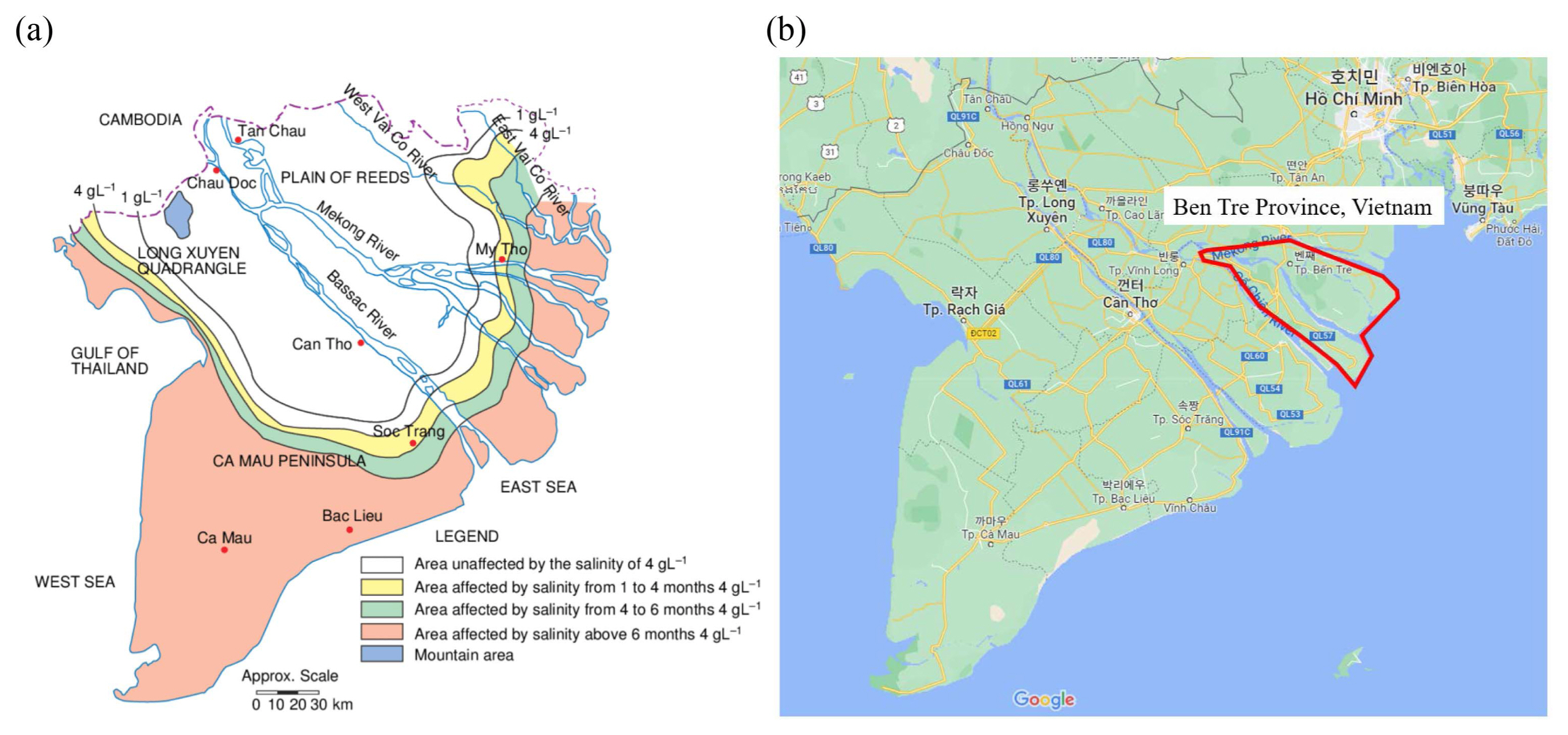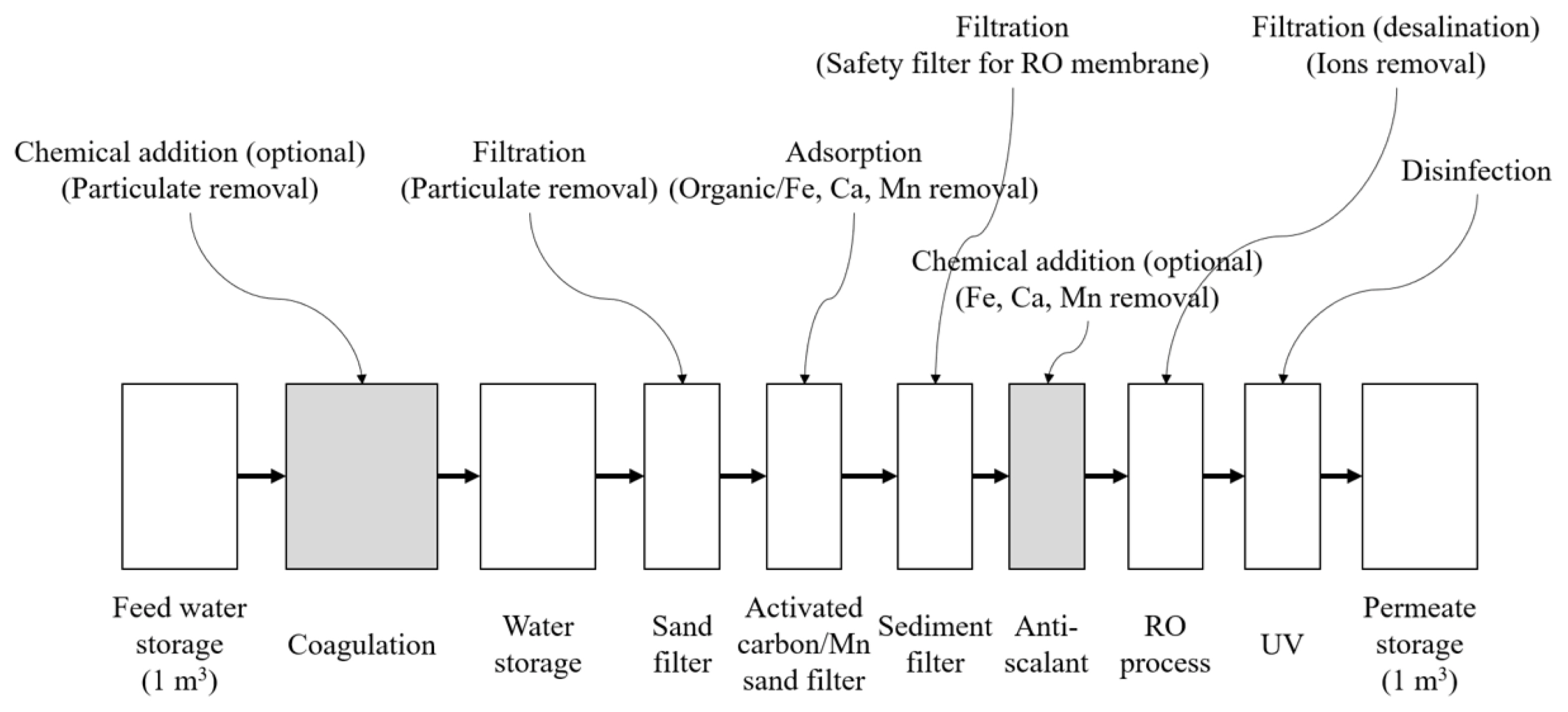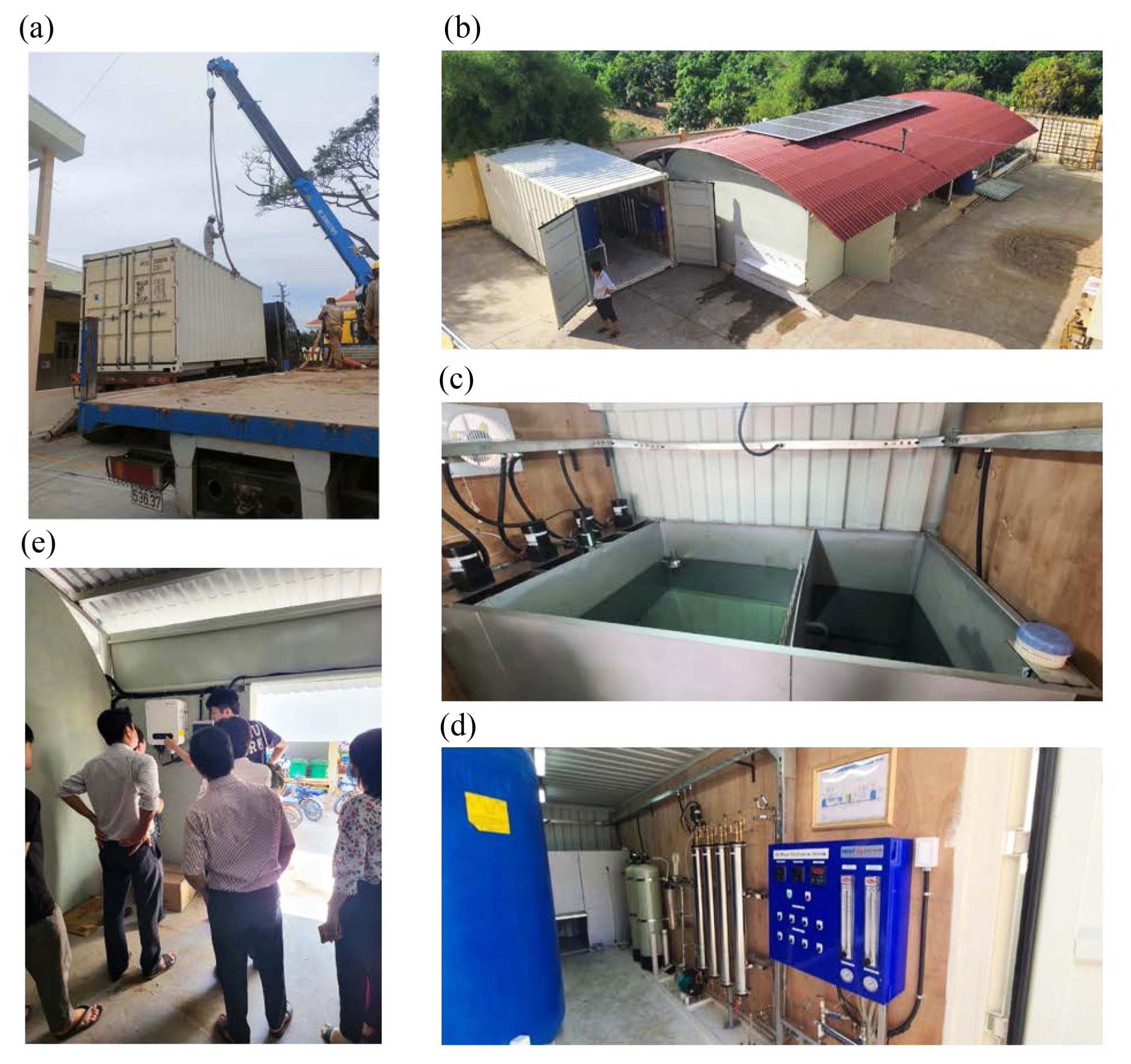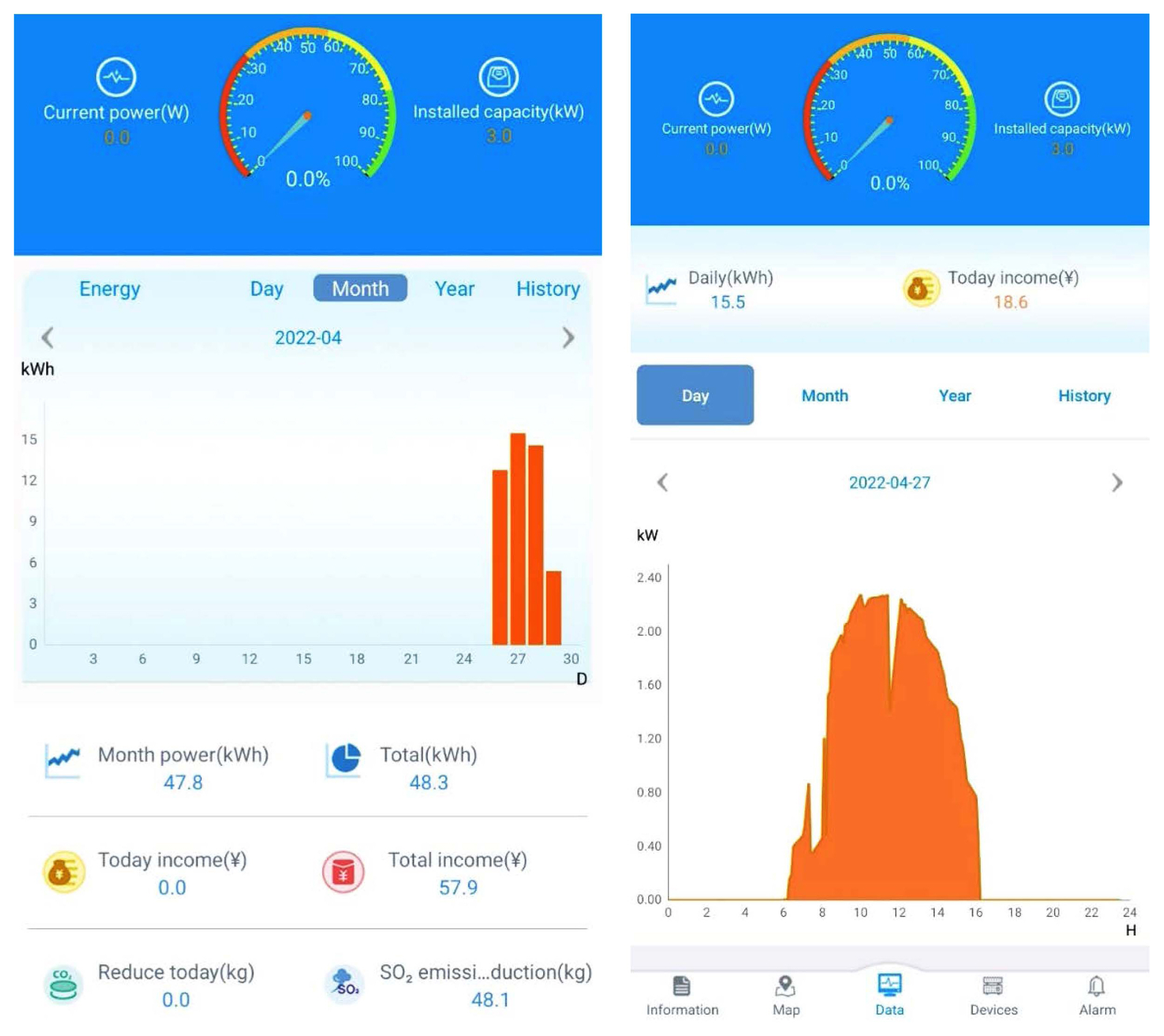Installation of the Brackish Water Reverse Osmosis System Coupled with Solar Power for Drinking Water Production in Ben Tre, Vietnam Considering Water Usage and Cost
Article information
Abstract
Recently, the unbalanced water demand and supply have been occurred globally due to the climate change, industrialization, and population increase. The water shortage problem became much severe in the developing countries because the low-stage of infrastructure might result in frequent limitation of water and transportation of water. Therefore, sustainable water supplying option is the key for the boosting the local economy. The Mekong Delta area produce most of the products in agriculture and fishery in Vietnam. However, due to low income and vast area, the infrastructure for water supply has been limited in the Mekong Delta area. Moreover, due to reduced Mekong-river flow by the dam construction in upper reaches, increased seawater level by the global warming, and increased unexpected drought and flooding by the climate change, the water supply in the Mekong delta is becoming hard. Therefore, sustainable water supplying option was required. In this study, the reverse osmosis-based desalination process could use undrinkable saline water as the feed water coupled with photovoltaic panel was suggested. In order to install the decentralized and off-grid type water production plant in the proper place in the Mekong Delta, the KIST, VKIST, and central and local governments in Vietnam collaborated. The RO plant could be successfully installed by the help of the partners and the operational conditions have been monitored. If the water providing option could be separated according to the purposes such as drinking usage and other water usage, the more technical options could be applied for the water production.
Introduction
In Vietnam, the Mekong Delta area is the most productive region for agriculture and fishery. The major products are rice crop and wild fish capture or aquaculture (fish or shrimp) (Van Kien et al., 2020). Major water sources in the Mekong Delta are rainwater and groundwater. Recently water shortage for local people and agriculture has been occurred due to increase of the salinity in the groundwater resulted from the decrease of flows in Mekong River and sea-level rise (Smajgl et al., 2015). Off-grid and decentralized system is required in Mekong Delta due to lack of construction cost for vast Mekong Delta area with highly distributed low population. However, there is sufficient solar energy in Mekong Delta area (Tuan et al., 2011). Therefore, it is required to install the system which can utilize abundant solar energy as the power source.
Due to climate change and increase of water demand, the global lack of water has been occurred severely (Nguyen et al., 2021a). UN expected that 2.7 billion people in the world might experience water shortage in 2030 (Hoekstra et al, 2012). However, the fresh water is limited because the most of water in earth is seawater. Therefore, non-conventional water resources including seawater and wastewater by using the desalination, water reuse, and water storage processes have been considered as the new water source (Nguyen et al., 2021a, Jeong et al., 2021, Ma and Jeong, 2021, Nguyen et al., 2020, Nguyen et al., 2021b, Nguyen et al., 2022).
In the Mekong Delta area, the major water sources were groundwater and rainwater due to limitation of the freshwater from Mekong-river. Due to seawater intrusion to groundwater, the desalination technology was required to produce freshwater from the brackish water (1,500–15,000 mg/L as TDS). The economically feasible desalination technologies which have been suggested for the brackish water treatment were reverse osmosis, forward osmosis, membrane distillation, electrodialysis, capacitive deionization, and multi-effect distillation coupled with solar power collectors for heat or photovoltaic panel for electricity.
In this study, the conventional brackish water RO (BWRO) system was chosen for the drinking water production in order to provide sustainable water source which could satisfying drinking water standard in Vietnam. Moreover, proper education for the local operator and continuous after service was also required. Therefore, the collaborator from the industry side was needed who had the multiple references of the pilot plant installation and operational experiences at least several years in the developing countries. Moreover, the photovoltaic panel was required in order to decrease energy cost during the BWRO operation and to respond the uncertainty of the electrical supply in the local area. Moreover, the governmental and technical supports from Vietnam were essential to install successfully the water production system in Mekong Delta area when it was considered that the pilot plant should be installed during the limited project periods.
Therefore, in order to provide proper drinking water supplying option in the Mekong Delta area, the water usage and price were investigated. And the expected water production costs by the decentralized and centralized RO systems according to the pilot scale were compared by using the references. The works related to installation of the 10 m3/day BWRO system coupled with photovoltaic panel were summarized. The keen collaborative work among the different groups (Korea Institute of Science and Technology (KIST), Glory & Tech, VKIST, Ho Chi Min City University of Technology (HCMUT) and central and local governments in Vietnam) was reported according to the project schedule.
Materials and Methods
1. Target area
The location for application of the BWRO system was Ben Tre, Vietnam. As shown in Figure 1(a), coastal area in Mekong Delta is experiencing salt intrusion in the groundwater which is one of the major water sources (Castillo et al., 2003). Therefore, the target area for the BWRO system was the near the coastal area in Ben Tre Province. Target sites (kindergarten and primary school) as shown in Figure 1(b) were suggested by the Vietnam local government which had water quality and quantity problems. The water qualities (turbidity, permanganate index, total hardness, total dissolved solids (TDS), concentrations for NH4+, Cl−, NO3−, As, Al, Fe, Mn, and total coliforms) for the collected samples on 24th September, 2020 according to the drinking water standard in Vietnam were measured in the Ho Chi Min City University of Technology (HCMUT). The water characteristics were considered to determine the target site for pilot plant installation.

The maps of (a) the salt intrusion in the Mekong Delta area (Castillo et al., 2003) and (b) target area for BWRO system in the Ben Tre Province, Vietnam (Google map, 2022)
2. BWRO system
The 10 m3/day BWRO system (Figure 2) was designed by the Glory & Tech based on the expected salinity in the feed water (by the salt water intrusion). In order to respond the sudden excessive particulates from the feed water, the coagulation system which could add coagulant optionally was included. The series of the filtration and adsorption filters were located before the RO process. The sand filter was required to remove particulate mainly. In order to remove organic matters and expected scalants (Fe, Ca, or Mn ions) for RO membrane in the feed groundwater, activated carbon/manganese sand filter was included. Additional safety filter was added before the RO process to respond unexpected operational failure of the pre-treatment processes. The anti-scalant could be injected optionally before the RO process when the removals of Fe, Ca, or Mn ions were not sufficient. Generally, the chemical addition processes such as coagulation and anti-scalant addition should be included to guarantee safe operation of the RO process, however, the BWRO system also required proper operation with the low operational cost and low management. Therefore, in this BWRO system the chemical addition process was designed as the optional process. The BWRO process was consisted of 4 RO membranes (4040 membrane: 4 inch (about 10 cm) in diameter and 40 inch (about 1 meter) in the length) as the 10 m3/day scale. The disinfection process using the UV lamp was followed in the end.
3. Installation and operation
The pilot plant in container was assembled in Korea and it was transported to the Ho Chi Min City port by ship. And the pilot plant in container was transported to the Ben Tre by truck. The crane put the system in the proper position. The additional building for PV panel was newly built.
The water qualities of the collected feed (tap water) and permeate of the BWRO plant were measured from the Pasteur Institute Ho Chi Minh City (http://www.pasteurhcm.gov.vn). The 16 components in water were measured according to the ‘national technical regulation on domestic water quality (QCVN 02: 2009/BYT)’ in Vietnam (Glory & Tech, 2022) on April 28th, 2022.
4. Survey on water usage and cost in Vietnam
In order to understand the water usage in Vietnam, the water usage in Vietnam was collected from the reference (Otaki et al., 2013). And the water usages according to the countries were also investigated from the reference to compare the water usage among the countries (Human Development Report, 2006). In Vietnam, especially for the Mekong Delta area, people purchase the bottled water for the drinking water. Therefore, the market prices of the bottled water were investigated from the online markets in Vietnam (https://thewaterman.vn/ and https://speedl.vn/). In order to compare the water prices in Korea, the market price of the bottled water and supplying cost of the tap water were investigated (Yang et al., 2020). Moreover, in order to estimate the water price from the desalination process, the references were searched for the cost analysis according to the scale of the desalination process (Nguyen et al., 2021; Pan et al., 2020; Al-Karaghouli and Kazmerski, 2013; Arroyo and Shirazi, 2012; Hwang and Kim, 2016; Carlsbad Seawater Desalination Project, 2008; Spiritos and Lipchin, 2013).
Results and Discussions
1. Water usage and prices in Vietnam
There were huge variations in average daily water consumption (L/day/capita) like as US 550 L/day/capita, France 250 L/day/capita, UK 150 L/day/capita, Bangladesh 50 L/day/capita, and Cambodia 20 L/day/capita (Human Development Report, 2006). Otaki et al. (2013) measured average water consumptions as 60.9 L/day/capita of total, including 18.6 L/day/capita for toilet flushing, 16.2 L/day/capita for clothes washing, 10.4 L/day/capita for bathing, and 15.7 L/day/capita for cooking in Hanoi (Capital city in Vietnam) for 56 households. It could be worth to mention that 60.9 L/day could be required for each person in Vietnam. The required water amount in Vietnam was not high compared to the other developed countries.
In Vietnam, especially in the Mekong Delta area, the bottled water is used as the major drinking water source. As shown in Table 1, the costs of water in Vietnam and Korea were listed. The cost of bottled water in Vietnam was similar to that in Korea. When the water costs were simply compared, the desalinated water by using the seawater from the small-scale (10–500 m3/day) desalination plant was even cheaper than the cost of bottled water in Vietnam. It could be assumed that only 2 L of drinking water is required per capita and other water usages such as washing and cleaning could be compensated by the rainwater or tap water in the rural areas in Vietnam.
The average water cost (0.184–0.44 $/60.9 L = 3.02–7.22 $/m3) considering average water consumptions in the rural area of Vietnam could be calculated if the drinking water (2 L) was provided by the bottled water (92–220 $/m3 = 0.092–0.22 $/L) and the other water (58.9 L) was compensated by the collected rainwater (0 $/m3). Therefore, the small-scale (10–500 m3/day) SWRO plant could not be feasible to provide all the required water in the rural area. The cost of large scale SWRO desalination plant could provide water cost cheaply, however, the centralized-type water production system is economically feasible when the system provides the water nearby (small pipeline cost). However, the water demands are distributed far each other (which is increasing pipeline costs) in Mekong Delta area, the centralized system could not be applied except big city like as Can Tho. Therefore, one of the possible options for providing water sustainably without the quality and quantity issues by using the salted groundwater as the feed solution could be the commercialized BWRO system.
If the SWRO plant could be operated to provide drinking water only, the multi-paths water supplying option (providing drinking water only by using the water purification system and asking to use rainwater as the other water uses to the citizen) could be economically feasible. However, due to the expected increasing demand for the safe water from the citizen, the multi-paths water supplying option could not be the sustainable strategy for the Mekong Delta area, Vietnam and for the rural areas in Korea.
2. Design and preparation of the BWRO pilot plant
The schedule during 2020 for the preparation and installation of the BWRO system was shown in Figure 3. The KIST and Glory & Tech discussed to prepare the installation of the BWRO system in the Mekong Delta area. The construction, transportation, and education for the local operator methods also included for the design period. Discussions among KIST, VKIST, and central and local governments in Vietnam were made to install the pilot plant in the target area. During the determination of the target area, the Ben Tre Province was suggested by the central government in Vietnam and the detailed candidates for pilot plant installation were suggested by the local government in Vietnam. The target site of pilot plant application was determined by the discussions among the KIST, VKIST, and the local government in Vietnam. The local government provided the availabilities for sustainable electricity including electricity fee during the pilot operation, local operator, and stable foundation against the weight of the pilot plant according to the target areas. The members in VKIST, HCMUT, and local government in Vietnam were visited target areas in order to confirm the obtained information and collected the water sample. KIST asked to the HCMUT for water quality analysis because travel to Vietnam was prohibited due to COVID-19.
3. Determination of the target site in Ben Tre Province, Vietnam
3.1 Feed water quality
As shown in Table 2, the water qualities of the target sites were measured. The turbidity, permanganate index, total hardness, TDS, NH4+, Cl−, As, Fe, Mn, and total coliforms of collected water from the well in the kindergarten exceeded those of drinking water standard in Vietnam. The reason for the high concentration in the well could be the saline water intrusion (total hardness, TDS, Cl−), geochemical reaction between groundwater and aquifer (total hardness, TDS, As, Fe, Mn), and contamination from the surface water by the human activity (turbidity, permanganate index, NH4+, total coliforms). Though the tap water showed better water quality than the well water, still several water indexes (turbidity, total hardness, Cl−, Fe, and total coliforms) exceeded the drinking water standard in Vietnam.
3.2 Determination of target location
Though the water quality of the well in the kindergarten was worth than that of the tap water in the primary school, the primary school was determined as the target location of the BWRO pilot plant application. The main reason for the determination was the TDS among the various water qualities, which is the most important parameter for sustainable operation of the BWRO system because the required pressure to operate the reverse osmosis process increases with the concentration of the ions (TDS). If the TDS increases more than 2,000 mg/L, the designed RO membrane cannot guarantee the proper water quality of the permeate and the designed pump could not provide enough pressure for the RO membrane. Moreover, the dry and rainy seasons in Vietnam are from December to May and from June to November, respectively. The water sample was collected in September which is rainy season, therefore, it might be expected that the water quality from the well in the kindergarten could be worth due to the reduction of groundwater recharge by the low rainwater infiltration.
4. Installation of the BWRO system in the target area and collaboration during the installation
Due to the COVID-19, the transport from Ho Chi Min City to Ben Tre Province was prohibited as shown in Figure 4. VKIST and local government discussed several times to get the allowance of the transport between Ho Chi Min City to Ben Tre Province. After several months’ discussion, the transport was allowed and the discussion of the transport from Korea to Vietnam by the ship could be started. In order to export the container type RO system, KIST, VKIST and local government were prepared the required documents for the shipment in order to allow the property into Vietnam and to minimize the evaluation time in the port. Finally, the RO container successfully arrived in the Ho Chi Min port. However, additional transport prohibit from Ho Chi Min City to Ben Tre Province was occurred due to COVID-19. More discussions made between VKIST and local government. Finally, after several prohibition, the container type RO pilot could successfully be arrived and be installed in the target area in Ben Tre Province, Vietnam. And test operation and education for pilot plant operation were conducted at the end of April, 2022 as shown in Figure 5.

Pilot plant installation schedule in 2021–2022 including transportation and installation of the BWRO pilot plant
5. Operational results of the BWRO system
As shown in Table 3, the water qualities of feed and permeate from the BWRO pilot plant were listed. Most of the water qualities satisfied the drinking water standard in Vietnam except total coliforms and chlorine concentration in the feed solution. And after the BWRO treatment, all the water qualities satisfied the drinking water standard in Vietnam. During the design of the BWRO system and determination the location of the target area for pilot plant application, it was expected that the water quality in the dry and rainy seasons might be significantly changed. However, the measured water quality did not change significantly according to the seasons. Therefore, additional measurements in water quality might be required in order to maintain the operational conditions of the BWRO system sustainably. Up to now, about 2 m3 of permeate has been produced for the drinking water for the 650 students during the 2 months of the operation.
The daily energy production by the PV-panel has been monitored by using the specially designed application connected with WiFi from the primary school as shown in Figure 6. The collected energy input and converted values such as CO2 reduction, SO2 emission reduction and income could be checked. The information could be used to understand solar irradiation in the target area and basic information for CDM (Clean development Mechanism) enterprise in the future.
Conclusions
The BWRO system (10 m3/day) coupled with the PV panel was successfully installed in the primary school in Ben Tre, Vietnam. The water quality (especially, Total hardness: < 5.00 mgCaCO3/L, TDS: < 51.0, Cl−: 18.6 mg/L, Total Coliforms < 1 CFU/100 ml) of the permeate water from the BWRO system satisfied the drinking water standards in Vietnam. The expected water usage and price in the Mekong Delta area, the feasible water production options could be the small-scale desalination process (BWRO). Further monitoring for the water production and energy compensation by the PV panel might be required to collect the operational data to deal with the maintenance issues of the BWRO pilot plant and further preparation for the CDM enterprise. Moreover, the collaboration among the KIST, VKIST and central and local governments in Vietnam could produce meaningful and practical help for the local people in the Mekong Delta area to solve the drinking water problem as the small approach. Later, it is expected that the more works could be managed by the VKIST to solve the water scarcity issue in the Mekong Delta area.
Acknowledgements
This work was supported by Korea Institute of Science and Technology (2Z06604).






